
Product Information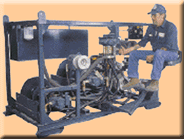
Winches/Hoists
Many manufacturers identify their lifting equipment as skid winches, others prefer the term erection hoists. An industry definition describes the hoist as the equipment; winching is what the hoist does. Some enjoy a pet name from their operator and crew ranging from Old Clyde to Bertha Blue. The implied intimacy with machines makes a world of sense in tower erection since the hoist is the lifeline that enables employees to welcome the end of another successful day.
The size and type of hydraulic hoist that a contractor will require is based upon the capacity of construction the erector normally performs. A single drum hoist can be the ideal equipment for antenna and line work and lifting lighter loads. A dual drum will enable the stacking of steel by using a gin pole which requires a jump and load line. A three drum winch is typically used for taller broadcast towers where the third drum can be used to draw up guy wires and perform other tasking requirements.
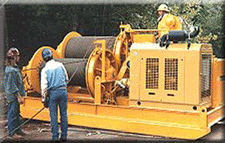 Single drum hoists are usually gasoline powered; diesel is the preferred choice for two or more drum hoists. One of the drums, typically the rear drum, can be designed for personnel lifting. It is normally larger so that it can maintain additional safety factors to meet design and liability requirements. Man-rated winches represent approximately 10% of the available hoists being used in wireless construction. Single drum hoists are usually gasoline powered; diesel is the preferred choice for two or more drum hoists. One of the drums, typically the rear drum, can be designed for personnel lifting. It is normally larger so that it can maintain additional safety factors to meet design and liability requirements. Man-rated winches represent approximately 10% of the available hoists being used in wireless construction.
The most requested wire rope sizes on a two drum hoist are 3/8” to 1/2” for the load line and 5/16” to 3/8” for the jump line. Some contractors will request aircraft cable as small as 1/4” on a single drum winch for lighter loads because of its ease of rigging and handling. Wire lengths will be based upon the rope and drum size. Rope capacity averages 2000 feet.
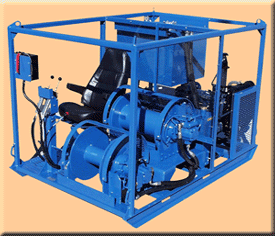 A 40 to 50 HP engine is a typical request for an average two drum hoist, 15 to 20 HP for a single drum. The brake should automatically apply in the event of loss of hydraulic pressure. All personnel rated drums must provide dual braking systems and the necessary accessories to meet OSHA requirements. The average line pull for a two drum hoist is 7,500 lbs. This will be reduced for personnel loads. A 40 to 50 HP engine is a typical request for an average two drum hoist, 15 to 20 HP for a single drum. The brake should automatically apply in the event of loss of hydraulic pressure. All personnel rated drums must provide dual braking systems and the necessary accessories to meet OSHA requirements. The average line pull for a two drum hoist is 7,500 lbs. This will be reduced for personnel loads.
Although manufacturers will provide maintenance and tear-down inspection recommendations, OSHA requires a tear-down 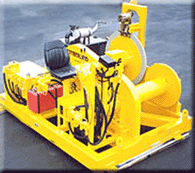 inspection in either a 6-month, 1, 2 or 3-year period depending upon the hoists’ usage. inspection in either a 6-month, 1, 2 or 3-year period depending upon the hoists’ usage.
Some areas of hoist safety that must be maintained at all times to be in compliance with OSHA requirements include:
- Hoist controls that are clearly identified and easily accessible to the operator
- An operator’s manual on site
- Documented daily inspections in
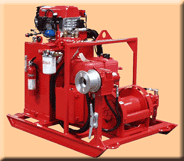 a logbook on site a logbook on site
- Load charts on site visible to the operator
- A secured hoist that is anchored for the load intended
- A functioning hour meter
- Moving parts that are fully protected
- Wire rope connections properly secured
- Tested two-way radios available for use if required
Having a qualified operator through certification or training is required in addition to using proper 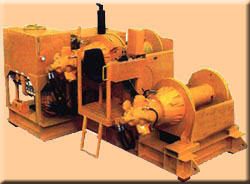 and inspected rigging equipment. If the hoist is approved for lifting personnel, a pre lift meeting must be held, documented and made available on site. A trial lift must be completed and documented as well. Personnel lifting baskets to be used must have an identification plate with the proper data detailing the weight of the lifting platform, the maximum intended load and the employee capacity. and inspected rigging equipment. If the hoist is approved for lifting personnel, a pre lift meeting must be held, documented and made available on site. A trial lift must be completed and documented as well. Personnel lifting baskets to be used must have an identification plate with the proper data detailing the weight of the lifting platform, the maximum intended load and the employee capacity.
Capstans, also known as catheads, 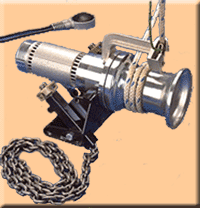 provide an excellent alternative when working with lighter loads, but they are never to be used for lifting personnel . Although this industry warning is well known, there have been numerous deaths caused by their misuse. There have also been multiple injuries and material damage from exceeding the capstan’s and rope’s capacity. The capstan’s safe working load must be visible on the equipment. It must be properly secured, free of grooves and the rope must be sized for the load being lifted. Capstans are available in either Gasoline or AC or DC powered units. Lifting capacities vary. provide an excellent alternative when working with lighter loads, but they are never to be used for lifting personnel . Although this industry warning is well known, there have been numerous deaths caused by their misuse. There have also been multiple injuries and material damage from exceeding the capstan’s and rope’s capacity. The capstan’s safe working load must be visible on the equipment. It must be properly secured, free of grooves and the rope must be sized for the load being lifted. Capstans are available in either Gasoline or AC or DC powered units. Lifting capacities vary.
NATE’s efforts provide relief to 200’ access ruling
Up until March of 2002, OSHA prohibited personnel from riding the line to their work station if it was located below 200 feet. This hoisting Compliance Directive has been changed through the dedicated efforts  of many National Association of Tower Erectors (NATE) member companies that worked in concert with the agency to identify that riding the line can be safely accomplished if guidelines were followed. The OSHA Directive provides instructions to tower erectors regarding riding the line. It also identifies personnel lifting hoist requirements for design, construction, installation, testing, inspection, maintenance, modification, repair and operations. of many National Association of Tower Erectors (NATE) member companies that worked in concert with the agency to identify that riding the line can be safely accomplished if guidelines were followed. The OSHA Directive provides instructions to tower erectors regarding riding the line. It also identifies personnel lifting hoist requirements for design, construction, installation, testing, inspection, maintenance, modification, repair and operations.
The instruction states that it applies only to the construction of new communications towers. It says activities such as maintenance, retrofitting, and dismantling will be addressed in a future directive. However, during the 2004 NATE conference, Rob Medlock, Area Director in the Cleveland area OSHA office, said that the instruction’s application seemed incongruous and he also questioned whether a procedure could be safe in one condition and unsafe in another. If the compliance directive was followed, but the employees were installing an antenna and rode the line to their work station, it would be doubtful that the contractor would be cited for willful violations or unsafe practices. Nevertheless, it is recommended that you contact a safety consultant for guidance.
 Hoist pricing will vary based upon the contractor’s requirements. A fully-equipped two-drum skid hoist meeting all current safety requirements will run approximately $35,000. If you want a man rated drum and the associated requirements, add approximately $8,000. Add your wire rope and freight charges. Capstans range from $1,600 for an AC or DC unit with a lifting capacity of 800 pounds, to $1,900 for a gas powered unit. Hoist pricing will vary based upon the contractor’s requirements. A fully-equipped two-drum skid hoist meeting all current safety requirements will run approximately $35,000. If you want a man rated drum and the associated requirements, add approximately $8,000. Add your wire rope and freight charges. Capstans range from $1,600 for an AC or DC unit with a lifting capacity of 800 pounds, to $1,900 for a gas powered unit.
We recommend that you contact our listed capstan, winch and hoist manufacturers and distributors to obtain additional information about their products and services.
|